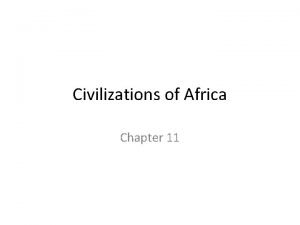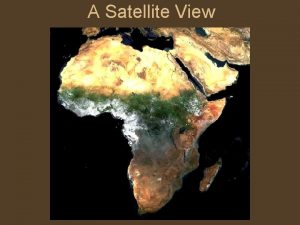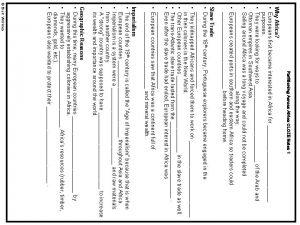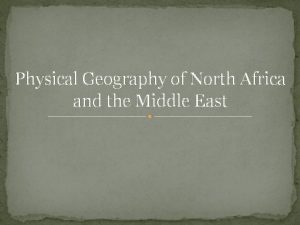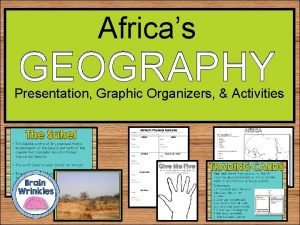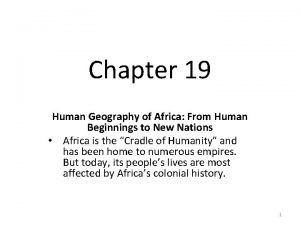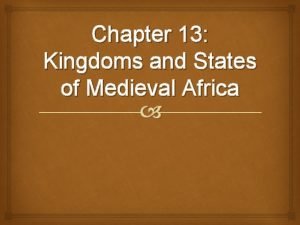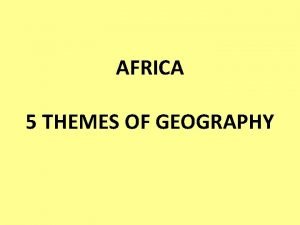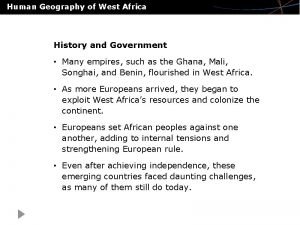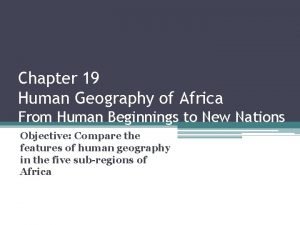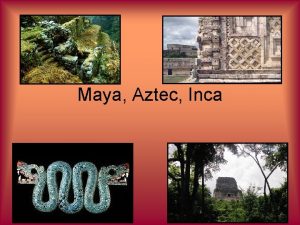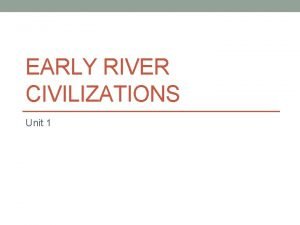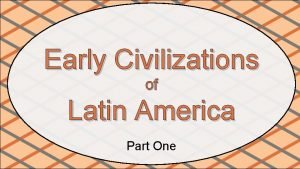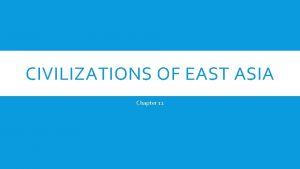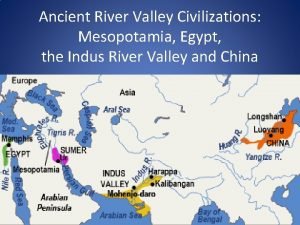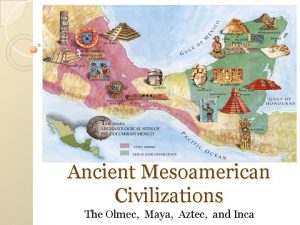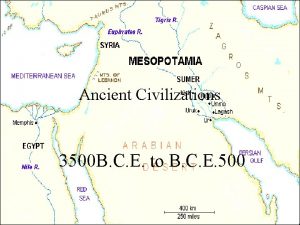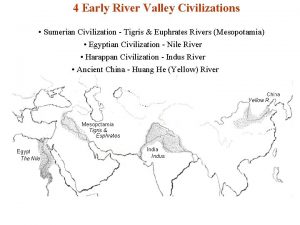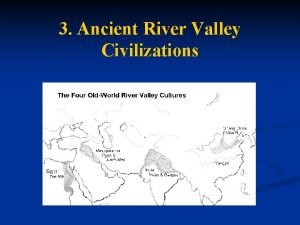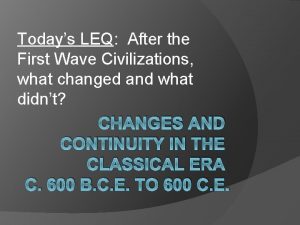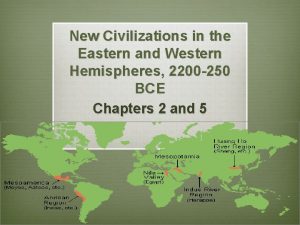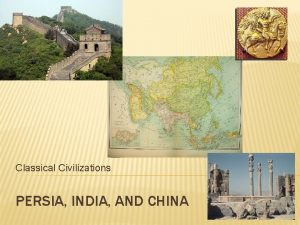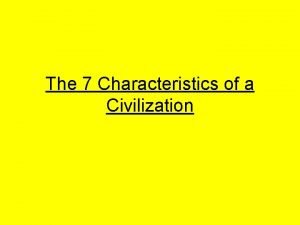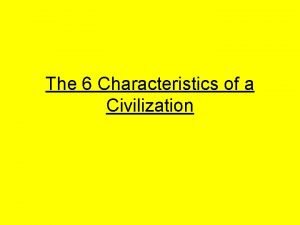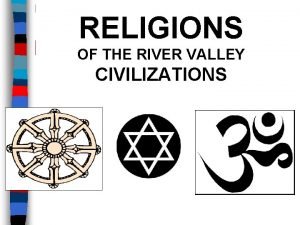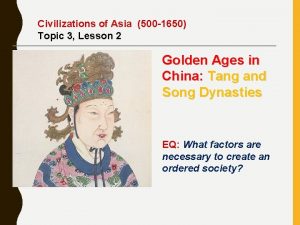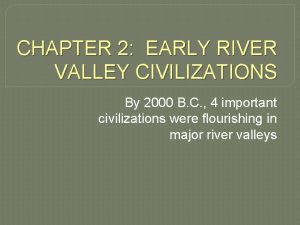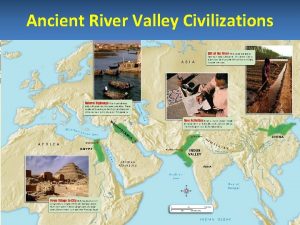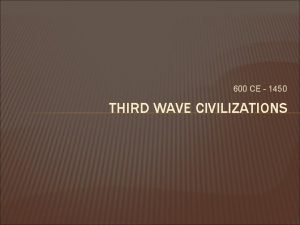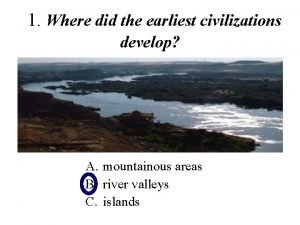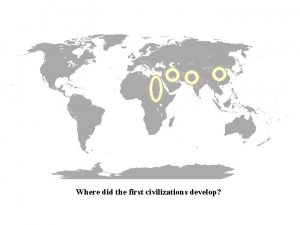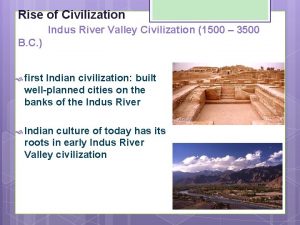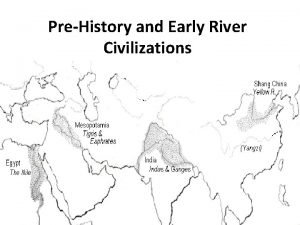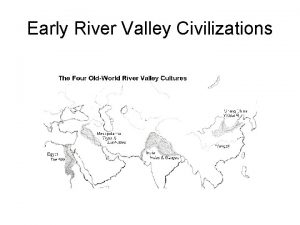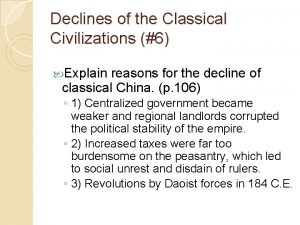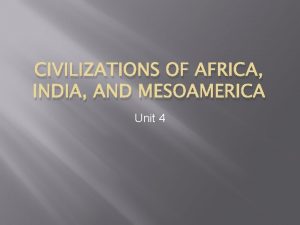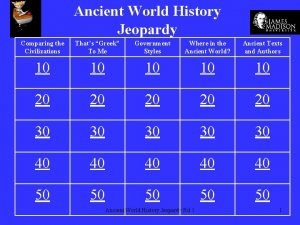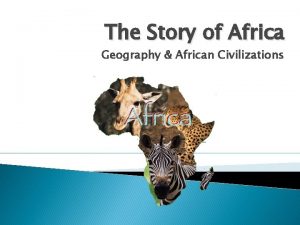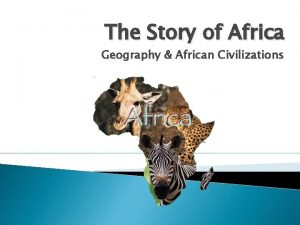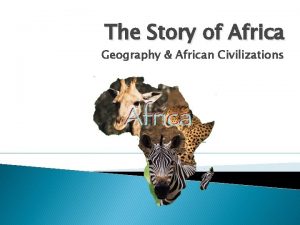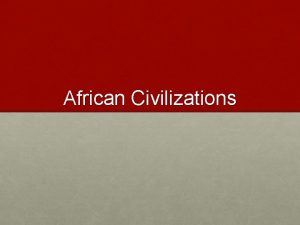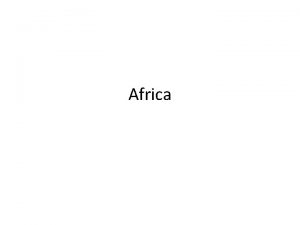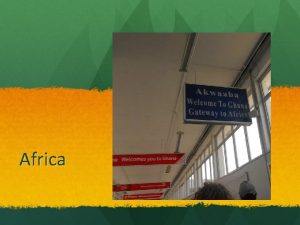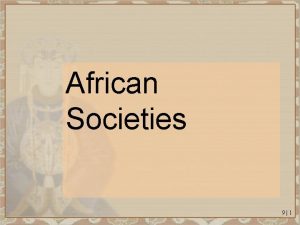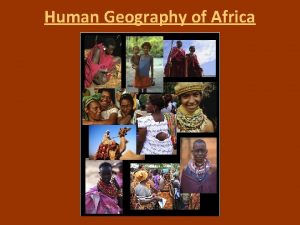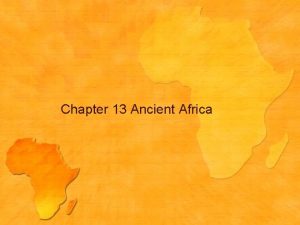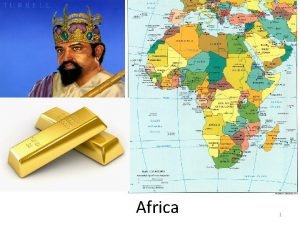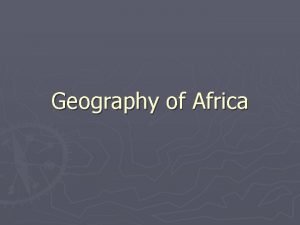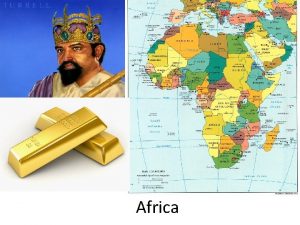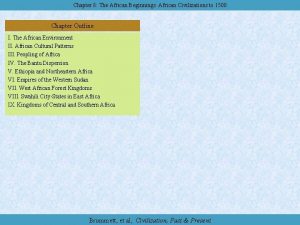The Story of Africa Geography African Civilizations Satellite
































![Sundiata [1210 -1260] “Lion Prince” Sundiata [1210 -1260] “Lion Prince”](https://slidetodoc.com/presentation_image_h2/e697b40f2c8b4d7889792c3d269bf10c/image-33.jpg)

![Mansa Musa [r. 1312 -1337] Mansa Musa [r. 1312 -1337]](https://slidetodoc.com/presentation_image_h2/e697b40f2c8b4d7889792c3d269bf10c/image-35.jpg)




![Sunni Ali [r. 1464 -1492] Sunni Ali [r. 1464 -1492]](https://slidetodoc.com/presentation_image_h2/e697b40f2c8b4d7889792c3d269bf10c/image-40.jpg)
![Askia Mohammed [r. 1493 -1529] Askia Mohammed [r. 1493 -1529]](https://slidetodoc.com/presentation_image_h2/e697b40f2c8b4d7889792c3d269bf10c/image-41.jpg)
![Askia Mohammed’s Tomb Gao, Mali [1443 -1538] Askia Mohammed’s Tomb Gao, Mali [1443 -1538]](https://slidetodoc.com/presentation_image_h2/e697b40f2c8b4d7889792c3d269bf10c/image-42.jpg)

![Kingdom of Axum [300 -700] Kingdom of Axum [300 -700]](https://slidetodoc.com/presentation_image_h2/e697b40f2c8b4d7889792c3d269bf10c/image-44.jpg)








![Great Zimbabwe [1200 -1450] “Zimbabwe” = “stone enclosure” Great Zimbabwe [1200 -1450] “Zimbabwe” = “stone enclosure”](https://slidetodoc.com/presentation_image_h2/e697b40f2c8b4d7889792c3d269bf10c/image-53.jpg)



![African Trade [15 c-17 c] African Trade [15 c-17 c]](https://slidetodoc.com/presentation_image_h2/e697b40f2c8b4d7889792c3d269bf10c/image-57.jpg)
- Slides: 57

The Story of Africa Geography & African Civilizations

Satellite View

Africa’s Size 4600 MILES 5 0 0 0 M I L E S # Second largest continent 11, 700, 000 sq. mi. # 10% of the world’s population. # 2 ½ times the size of the U. S.

Geography & African Civilizations 1. Geography of Africa a. 2 nd largest continent in the world b. 4, 600 miles from east to west; 5, 000 miles from north to south c. Narrow coastlines lie on either side of a central plateau d. Waterfalls or rapids form as rivers drop to the coast from the plateau making navigation impossible to or from the coast e. Coastline has few harbors, ports, or inlets f. Large deserts: the Sahara in the north and the Kalahari in the south g. Large rainforests with mahogany and teak trees that reach 150 feet tall h. Most people live on the savannas or grassy plains which include mountainous highlands and swampy tropical stretches i. The Nile River flows north in northeast Africa


The Mighty Nile River: “Longest River in the World”

The Niger River Basin # Covers 7. 5% of the continent. # Extends over 10 countries. # 2, 600 miles long.

Mt. Kilimanjaro: Snow on the Equator?

The African Plateau

The African Savannah: 13 million sq. mi.

The Sahara Desert

Desertification

Great Rift Valley 3, 000 miles long

West Africa: Home of our Hurricanes

Vegetation Zones

African Rain Forest # Annual rainfall of up to 17 ft. # Rapid decomposition (very humid). # Covers 37 countries. # 15% of the land surface of Africa.

as Atl a L. Chad--> ulf -G <- er Rift V alley Nile River of L. Tanganyika-> ori ese hari Kala rt e. Limpopo River Des Orange River Mts. rg bu s n aje r D Pacific Ocean rt Tropic of Capricorn 20° S Zambezi River Indian Ocean s. Mt Atlantic Ocean nz we Ru Co en Equator 0° Ad Great L. Albert--> er Δ Mt. Kenya Riv o ng L. Victoria Δ Mt. Kilimanjaro ib D AFRICA Se Sahel Nig er Riv Nam Of d Sahara Desert Complete Topography Libyan Desert Tropic of Cancer 20° N Re The Mediterranean Sea s. Mt

Geography & African Civilizations 2. Customs of Early Peoples a. Early peoples were nomadic b. Experts believe agriculture started in Africa roughly by 6, 000 B. C. c. The family was important and African people organized into family groups d. Many early cultures’ religions included elements of animism e. Animism: a religion in which spirits play an important role in daily life f. History was kept orally, not written down g. Bantu-speaking people migrated south and east leading to: i. Spread of farming techniques ii. Territorial wars iii. Intermarriages iv. Spread of technology such as copper, bronze, and iron work


Empire of Ghana Website

Natural Resources

Geography & African Civilizations 3. a. Early Civilizations of West Africa i. Empire of Ghana 800 A. D. Became a rich kingdom by taxing traders who traveled through their lands ii. Gold and salt were important & desirable trade items iii. By 800, Ghana was an empire iv. Only the king could own gold; acted as religious leader, chief judge and military commander v. Eventually Ghana’s rulers converted to Islam and had to learn Arabic; much of the population never converted vi. 1076 Muslim Almoravids conquered Ghana and disrupted the gold-salt trade vii. Ghana never regained its power

Gold-Salt Trade SALT GOLD Berbers

Salt

Salt Fields of Taghaza

Empire of Mali Website

Geography & African Civilizations b. Empire of Mali i. Emerged by 1235 south of Ghana; Mali’s wealth was also built on gold ii. Sundiata militarily took over Ghana; peace and prosperity followed iii. Some of Mali’s next rulers became Muslims and built mosques iv. Mansa Musa (Muslim) divided Mali into provinces and appointed governors v. Within 50 years of Mansa Musa, Mali’s gold trade shifted east and his successors were unable to govern the empire effectively

Timbuktu-”Heavenly Clay”

Timbuktu Rooftop, Mosque


Great Mosque at Djenne, Mali

Distant Mosque at Djenne, Mali
![Sundiata 1210 1260 Lion Prince Sundiata [1210 -1260] “Lion Prince”](https://slidetodoc.com/presentation_image_h2/e697b40f2c8b4d7889792c3d269bf10c/image-33.jpg)
Sundiata [1210 -1260] “Lion Prince”

European Map
![Mansa Musa r 1312 1337 Mansa Musa [r. 1312 -1337]](https://slidetodoc.com/presentation_image_h2/e697b40f2c8b4d7889792c3d269bf10c/image-35.jpg)
Mansa Musa [r. 1312 -1337]

Empire of Songhai Website

Geography & African Civilizations c. Empire of Songhai 1400 s i. Capital was Gao; extended their territory to the large bend in the Niger River ii. Two great Muslim leaders: Sunni Ali & Askia Muhammad iii. Created an empire through military conquest and efficient tax collecting iv. Unfortunately, Songhai lacked modern weapons v. Defeated by Moroccan invaders and ended 1, 000 years of W. African power

Crossing the Ocean of Sand

Desert Caravan
![Sunni Ali r 1464 1492 Sunni Ali [r. 1464 -1492]](https://slidetodoc.com/presentation_image_h2/e697b40f2c8b4d7889792c3d269bf10c/image-40.jpg)
Sunni Ali [r. 1464 -1492]
![Askia Mohammed r 1493 1529 Askia Mohammed [r. 1493 -1529]](https://slidetodoc.com/presentation_image_h2/e697b40f2c8b4d7889792c3d269bf10c/image-41.jpg)
Askia Mohammed [r. 1493 -1529]
![Askia Mohammeds Tomb Gao Mali 1443 1538 Askia Mohammed’s Tomb Gao, Mali [1443 -1538]](https://slidetodoc.com/presentation_image_h2/e697b40f2c8b4d7889792c3d269bf10c/image-42.jpg)
Askia Mohammed’s Tomb Gao, Mali [1443 -1538]

![Kingdom of Axum 300 700 Kingdom of Axum [300 -700]](https://slidetodoc.com/presentation_image_h2/e697b40f2c8b4d7889792c3d269bf10c/image-44.jpg)
Kingdom of Axum [300 -700]

Geography & African Civilizations 4. Early Civilizations of East Africa a. Aksum Empire i. Located on the horn of Africa on a plateau on the Red Sea ii. Conquered the Kush people who had been pushed south by the Assyrians iii. Traders from Egypt, Arabia, Persia, India, and the Roman Empire travelled though Adulis, Aksum’s chief seaport iv. They traded salt, rhinoceros horns, ivory, & gold v. Height of empire was 325 -360 under strong military leader Ezana vi. Monotheistic: worshiped Mahrem and believed king was his descendent vii. Aksum later becomes Christian viii. Depletion of soil and forests as well as Islamic invaders caused decline

Stele, Ezana’s Royal Tomb, Aksum (4 c)

Controlled NE African Trade AXUM’S ACHIEVEMENTS Written Language Built Stelae Terrace Farming Spread Christianity in No. & E. Africa


Geography & African Civilizations 5. Early Civilizations of Southern Africa a. Great Zimbabwe 1000 A. D. i. City built by Shona people that turned into an empire built on gold trade ii. Leaders taxed traders and travelers who ventured through iii. Great Zimbabwe was abandoned by 1450; no clear reason why iv. Much of what is known about Great Zimbabwe comes from impressive ruins

African Trade Routes

Arab Dow off the coast of Zanzibar

Great Zimbabwe ruins
![Great Zimbabwe 1200 1450 Zimbabwe stone enclosure Great Zimbabwe [1200 -1450] “Zimbabwe” = “stone enclosure”](https://slidetodoc.com/presentation_image_h2/e697b40f2c8b4d7889792c3d269bf10c/image-53.jpg)
Great Zimbabwe [1200 -1450] “Zimbabwe” = “stone enclosure”

Great Zimbabwe Street

Mutapa

Geography & African Civilizations b. Mutapa i. According to Shona legend, a man left Great Zimbabwe and settled a new site with fertile soil ii. A leader named Mutota dominated northern Shona people and were dubbed mwene mutapa meaning conqueror; thus the name Mutapa iii. Conquered all of modern day Zimbabwe iv. Gold was a cornerstone of their economy v. By the 1500 s the Portuguese unsuccessfully attempted to conquer Mutapa vi. This signaled increasing European interference in Africa for many centuries
![African Trade 15 c17 c African Trade [15 c-17 c]](https://slidetodoc.com/presentation_image_h2/e697b40f2c8b4d7889792c3d269bf10c/image-57.jpg)
African Trade [15 c-17 c]
 Chapter 11 section 1 early civilizations of africa
Chapter 11 section 1 early civilizations of africa Where is africa
Where is africa Partitioning across africa cloze notes
Partitioning across africa cloze notes Physical geography of north africa
Physical geography of north africa Temperate zone
Temperate zone Cultural geography of africa
Cultural geography of africa Chapter 15 lesson 1 physical geography of north africa
Chapter 15 lesson 1 physical geography of north africa Niger river
Niger river Geography webquest
Geography webquest Africa geography unit test study guide
Africa geography unit test study guide The mutapa empire thrived on the trade of diamonds
The mutapa empire thrived on the trade of diamonds Medieval africa geography
Medieval africa geography 5 themes of geography africa
5 themes of geography africa Medieval africa geography
Medieval africa geography North africa and southwest asia physical geography
North africa and southwest asia physical geography Human geography of west africa
Human geography of west africa Locate the sahara and the sahel. label them on your map
Locate the sahara and the sahel. label them on your map Chapter 19 human geography of africa
Chapter 19 human geography of africa How to write an frq for ap human geography
How to write an frq for ap human geography 5 themes of geography ap human geography
5 themes of geography ap human geography Proruption ap human geography
Proruption ap human geography Map of aztec inca mayan empires
Map of aztec inca mayan empires Yellow river civilization map
Yellow river civilization map Ancient river valleys map
Ancient river valleys map Early south american civilizations
Early south american civilizations Chapter 9 lesson 1 ancient india
Chapter 9 lesson 1 ancient india Lesson quiz 11-4 civilizations of east asia
Lesson quiz 11-4 civilizations of east asia 4 river valley civilizations
4 river valley civilizations What did the olmec live in
What did the olmec live in 3500 bce means
3500 bce means River valley civilizations map
River valley civilizations map Ancient chinese civilization
Ancient chinese civilization Second wave civilizations
Second wave civilizations Mediterranean civilizations location hemisphere
Mediterranean civilizations location hemisphere What was the significance of the metric act of 1866?
What was the significance of the metric act of 1866? What is it
What is it Similarities between inca maya and aztec
Similarities between inca maya and aztec World civilizations the global experience ap edition
World civilizations the global experience ap edition World civilizations the global experience 7th edition
World civilizations the global experience 7th edition What are the 7 features of civilization
What are the 7 features of civilization List the 6 characteristics of a civilization
List the 6 characteristics of a civilization River valley civilizations religion
River valley civilizations religion Topic 3 review questions civilizations of asia answers
Topic 3 review questions civilizations of asia answers River valley civilizations def
River valley civilizations def Civilization ppt template
Civilization ppt template Third wave civilizations time period
Third wave civilizations time period Where did the earliest civilizations develop
Where did the earliest civilizations develop Where did the first civilizations develop
Where did the first civilizations develop Clash of civilizations huntington
Clash of civilizations huntington Clash of civilizations huntington
Clash of civilizations huntington Indus river valley timeline
Indus river valley timeline River valley civilizations map
River valley civilizations map River valley civilizations vocabulary
River valley civilizations vocabulary 4 river civilizations
4 river civilizations What caused the decline of classical civilizations
What caused the decline of classical civilizations Quipus
Quipus World history jeopardy
World history jeopardy River valley civilizations characteristics
River valley civilizations characteristics
